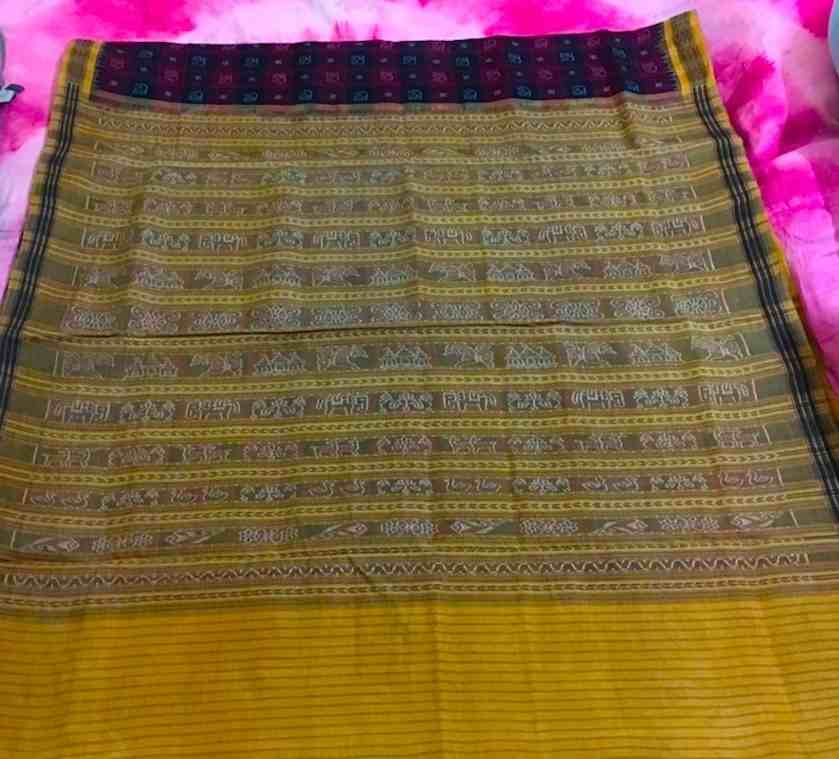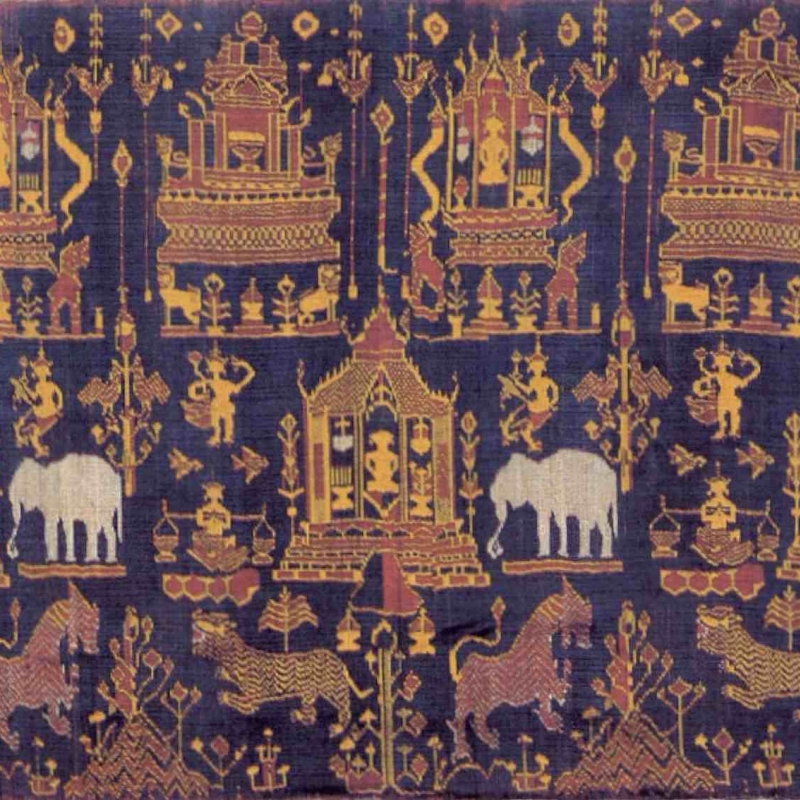Textiles weaving in India has been traditionally linked to rituals, both in process as well as in use. Here we explore put the spotlight on the sacred element in ikat textiles, traditionally considered a ‘magical’ cloth across communities in India and abroad. (In pic: Pidan, a sacred banner, from Cambodia, Khmer, 1880-1910, silk with weft ikat; Photo courtesy: Honolulu Academy of Arts/Wikimedia Commons)
The weaving of textiles in India has traditionally been considered a sacred, even meditative, act. There is a well-known mythological story that tells us of the creation of the padmasalis (the lotus-born)—the weavers caste—of southern India. According to the Markandeya Purana, sage Markandaya was asked to weave cloth to cover the nakedness of man and god. Since Markandaya did not know how, he offered a sacrifice. Out of the ashes appeared Bhavana Rishi, holding a ball of thread in his hands made from the stem of the lotus (padma). This was the same lotus stem erupting from Vishnu’s navel, which gave birth to Brahma. [1] And, thus, weavers came to be called padmasalis, marking the origin of the tradition of weaving.
Also read | The Sambalpuri Ikat of Odisha: History, Symbolism and Contemporary Trends
Other weaving communities have their own origin stories and texts that recount their evolution. This includes the invention and use of different types of looms, many using the body and its rhythm to weave. Traditional looms include the lion/backstrap loom, warp-weighted loom, handloom, draw loom, and others. When analysed, not only is there a yogic and meditative element to the process of weaving by using one's breath, but the element of sacredness is continued with the use of the cloth for ritualistic purposes, giving it an additional quality of divine purpose. One such cloth is the ikat.

String Theory
Textile historian Jasleen Dhamija describes the spiritual aspect of ikat traditions in Sacred Textiles of India: ‘The completed ikat was considered a powerful magical cloth, imbued with the ability to cure, to heal, to purify and to protect,’ and that ‘the dyeing of thread and the process of its weaving are interlinked in the creation of the pattern.’[2] Though ikat—which finds roots in the Indonesian/Malay word mengikat (to tie or bind)—is found in numerous cultures around South, South East and Central Asia, as well as Japan and Central and South America, it is widely used for religious activities across India and is considered a sacred cloth.
Also read | Weaver Communities of India
The Sambalpur region of Odisha is considered the hub of ikat weaving in India. Naturally, the cloth has links to the religious practices of the region. It is believed the Vichitrapuri saris of Sambalpur were worn by Lord Jagannath’s devadasis (attendants), when they were ritually married to him at the temple in Puri. There is the Gita Govinda fabric, used to drape Lord Jagannath, which is woven by Nuapatna weavers, features verses from the 12th-century Krishna poem by Jayadeva, explains khandaani weaver and textile historian Surendar Meher.[3]
Elaborating on the religious aspect of the saris from Odisha, Judith H. Livingston, in her essay, ‘Ikat Weaves of Indonesia and India: A Comparative Study’, wrote:
‘Symbolic patterns used in the saris are the lotus as a symbol of the universe emerging from the sun, the conch representing the mystic symbol "om", the rudraksha seeds worn by devotees of Lord Shiva, the fish as one of the eight symbols of good luck, the tortoise as the second incarnation of Lord Vishnu, the coiled serpent symbolising the unending cycle of time, the peacock signifying prosperity, the elephant and the dharma-chakra.’[4]
Kerala Connection
While Sambalpur is synonymous with ikat weaving, the tradition flourished in other regions across India as well. Gujarat is well-known for its double ikat patola weave, here weft and warp threads are tied and then dyed before weaving them, but not many know of the Kerala connection. In the southern state, the patola was used for ritual purposes and as a protective cloth during the procession of the goddess Bhadrakali. Though it is unclear how the patola found a market in Kerala, Dhamija notes that ‘it is possible that patola were known in Kerala as powerful cloths from ancient times’.

The Western Front
In Gujarat, patola saris flourished with the arrival of the Salvi community—said to be Digambar Jains who had migrated from the Deccan—and became an important aspect of the religious and social life. The red patola sari is wrapped around the bride in various Gujarati communities only after the marriage vows have been completed and she has undergone the transformation from a kanya (virgin) to a vadhu (a bride). Dhamija, who has extensively written on the sacredness of textiles, writes that not only is the ikat revered in these communities, it is never discarded and old saris are used to cover an infant’s cradle as it is believed the cloth protects the infant from ‘the witches who suck out the life of the unguarded sleeping infant’.[5]
While these are some examples of how ikat is used for ritualistic purposes in India, this aspect is also common to numerous regions around the world, including Japan, Central Asia, the Philippines and even some parts of South America. Today, ikat designs reflect the religious and ritualistic motifs that have been passed on from generation to generation. It is one of the few industries that have managed to stay unaffected by machines as they have failed to reproduce what the fine touch of a weaver. It continues to flourish and its intricate dyeing and weaving process has been demonstrated around the globe as an example of craftsmanship.
The article was also published on The Statesman.
Notes
[1] Jasleen Dhamija, ‘Ritual Textiles and the Cult of Ikat’ in Sacred Textiles of India, ed. Jasleen Dhamija (Mumbai, The Marg Foundation, 2014), 16.
[2] Ibid, 19.
[3] Surender Meher, ‘The Sambalpuri Ikat of Odisha: History, Symbolism and Contemporary Trends’, Sahapedia, 2017.
[4] Judith H. Livingston, ‘Ikat Weaves of Indonesia and India: A Comparative Study,’ India International Centre Quarterly 21, no. 1 (1994): 152-74. http://www.jstor.org/stable/23003922.
[5] Jasleen Dhamija, ‘Ritual Textiles and the Cult of Ikat’ in Sacred Textiles of India, ed. Jasleen Dhamija (Mumbai, The Marg Foundation, 2014), 22.













